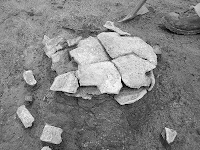The
Protostegid Turtles were a group of Turtles known from the Cretaceous
that are thought to have been members of the Chelonioidea, the group
that includes the two living Marine Turtle groups, the Chelonidoidea
(Sea Turtles) and Dermochelyidae (Leatherback Turtles), and like
these living groups are considered to have been true ocean-dwelling
Turtles. A number of putitative 'Marine Turtles' are also known from
Jurassic deposits in Europe and South America, but these are mostly
incomplete, and none can be confidently shown to have been a true
sea-dweller. None off these Jurassic Turtles is thought to be closely
related to the living Marine Turtles, so if they were genuinely
seagoing then they represent a separate evolutionary lineage that
does not appear to have survived into the Cretaceous. As such the
Protostegids are generally considered the oldest true Marine Turtles.
In
a paper published in the journal PaleoBios on 7 September 2015, Edwin
Cadena of the Centro de Investigaciones Paleontológicas and the
Department of Paleoherpetology at the Senckenberg Naturmuseum and
James Parham of the John D. Cooper Archaeological and PaleontologicalCenter at California State University describe a new species of
Protostegid Turtle from the Early Cretaceous Paja Formation of Boyacá Department, Colombia. The Paja Formation is well known for its fossil
vertebrates, which are preserved in ferruginous-calcareous nodules
and concretions, often with layer of ferruginous oxides covering and
infilling cavities in the bones. The formation has previously
produced Marine Reptiles, a variety of Fish and a Dinosaur.
The
new species is placed in the genus Desmatochelys,
and given the specific name padillai,
in honour of the late Carlos Bernardo Padilla, who led a number of
palaeontological expeditions in the area, and helped to find some of
the specimens from which the species is described, The species is
described from eight specimens, the most complete of which comprises
a complete skull and jaw plus part of the post-cranial skull,
including the most of the forelimbs and carapace (shell). The other
specimens comprise two complete skulls, one adult and one juvenile,
three incomplete skulls one adult and two juveniles and two partial
carapaces. One of these partial specimens has been listed as
Desmatochelys sp.
In previous works, but not enough material was know at the time to
formerly describe it as a new species
Desmatochelys
padillai preserved
in ventral view, holotype. For the bottom figure; light grey areas
represent portions of the plastron and portions of the pectoral
girdle are shown in dark grey. Cadena & Parham (2015).
Some
previous examinations of the phylogenetic position of the
Protostegids have suggested that they may not actually be members of
the Chelonioidea, and may be paraphyletic (i.e. not a true grouping
with a single common ancestry). A phylogenetic examination of the
Chelonioidea including Desmatochelys
padillai using
the PAUP phylogenetic software package (computerised phylogenetic
systems are widely used in taxonomy, as they are capable of assessing
larger numbers of species and character traits, and cannot harbour
biases – pet theories which are sometimes hard for human assessors
to reject) recovered the Protostegids as true members of the
Chelonioidea, with Desmatochelys
padillai,
at 120 million years old, being the oldest member of both groups.
Chronostratigraphic
distribution of Pan-Chelonidoidea clade. Solid square-rectangles at
the tip branches are based on the fossil occurrences. White
rectangles represent fossils that show the age of the stem lineages.
Note that some taxon ranges are long due to stratigraphic uncertainty
and should not be interpreted as illustrating a continuous fossil
record. Taxon ranges for fossil occurrences were taken from
literature. Cadena & Parham (2015).
See also...
 A new species of Turtle from the Late Cretaceous of Morocco. Turtles are aquatic reptiles with a shell that encases their body, and
into which the head and limbs can be retracted at least partially. They
have a fossil record that dates back to the Late Triassic, about 220
million...
A new species of Turtle from the Late Cretaceous of Morocco. Turtles are aquatic reptiles with a shell that encases their body, and
into which the head and limbs can be retracted at least partially. They
have a fossil record that dates back to the Late Triassic, about 220
million... A Geomydid Turtle from the Miocene of Tanegashima Island, Japan. Geomydid Turtles are found in rivers, ponds and shallow marine
environments across the tropical and sub-tropical regions of Asia,
Europe and the Americas. They are variously known as Box Turtles, Pond
Turtles or Wood Turtles. The classification of Geomydid...
A Geomydid Turtle from the Miocene of Tanegashima Island, Japan. Geomydid Turtles are found in rivers, ponds and shallow marine
environments across the tropical and sub-tropical regions of Asia,
Europe and the Americas. They are variously known as Box Turtles, Pond
Turtles or Wood Turtles. The classification of Geomydid...  A Jurassic Turtle bone-bed from the far northwest of China. Turtles are aquatic reptiles with a shell that encases their body, and
into which the head and limbs can be retracted at least partially. They
have a fossil record that dates back to the Late Triassic, about 220
million...
A Jurassic Turtle bone-bed from the far northwest of China. Turtles are aquatic reptiles with a shell that encases their body, and
into which the head and limbs can be retracted at least partially. They
have a fossil record that dates back to the Late Triassic, about 220
million...
Follow Sciency Thoughts on
Facebook.


